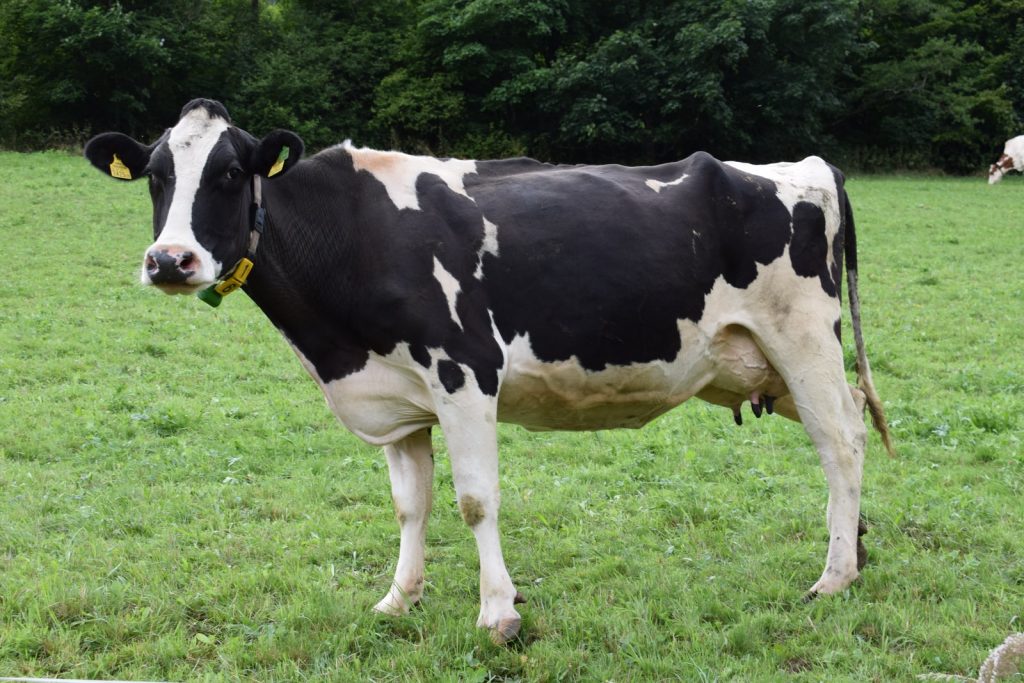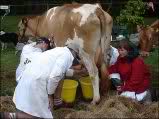Temperate breeds of dairy cattle that have been raised successfully in the Philippines are the Holstein Friesian, the Jersey, and the Brown Swiss.

The Holstein-Friesian has an average daily milk production of 22 kilograms with an average butterfat content of 3.6 per cent. The Jersey produces an average of 13 kilograms of milk while the Brown Swiss has 17 kilograms. The average butterfat content is 5.2 per cent and 4 per cent respective.
Tropical breeds such as the Sahiwal, the Red Sindhi, and the Tharparkar are more adapted to Philippine conditions. But these are dual-purpose breeds raised for both their meat and milk and they produce less milk than the temperate breeds.
The average daily milk production of the Sahiwal is eight kilograms with a butterfat content of 4.9 per cent. Both the Red Sindhi and the Tharparkar have an average daily milk production of six kilograms with about 4.3-6 and 4.9 per cent butterfat content, respectively.
The selection of a milking animal may be based on records of its pedigree, ancestors or family. In the absence of records, however, selection should be based on a thorough physical evaluation of the animal, and on such traits as milk yield, mothering ability and growth rate. A good dairy cow should be free from abnormalities, possesses a good temperament, and have large, well-developed udder with uniform, functional teats.
A cow’s productivity can be determined by measuring its milk yield based on a 305- day mature equivalent (M.E. or age of highest average production), twice-a-day milking basis.
Housing. Protect the animals against too much heat and rain- particular during milking time. Construct an open-air corral as shed for the cattle. A fenced area of 12 ft x 12 ft is enough for 4 to 5 cows. An area of 10 ft x 3 ft as shed barn and feeding trough will suffice.
Calves should be raised in structures constructed two feet from the ground, 4 ft x 8 ft in area. A 4-foot high partition is needed to easily separate the calf from the mother if you decide to milk twice daily.
If milking is done only in the morning, a separate enclosure must be provided the calves within the open-air corral.
Maintain cleanliness in the area. If possible, the floor should be cemented and well-drained. Provide adequate feed, water and grass racks for animals.
Two compartments with chutes are needed in order to control the cows. In a four-to five-cow dairy, three to four cows will be in the milking line.
Breeding. The young cow and bull should not be mated too early for it will retard their growth and may produce weak offspring. Breed the cow when she is about 18 months old or when weighing about 200 to 250 kilograms. The bull should be at least two to three months older than the cow.
A cow is bred sixty days after calving. If the cow is in heat in the morning, breed her in the afternoon; if the cow is in heat in the afternoon breed her the following morning. Be sure to breed only once.
Upon calving, separate the calf immediately from its mother and put it on an elevated platform. However, if you milk your cow only in the morning, you can separate the only at night.
System of raising dairy cattle. There are two system of raising dairy cattle: zero-grazing and grazing.
In zero-grazing, the cattle are not allowed to graze in the field. Instead, the pasture-which is planted to different varieties of grasses and legumes-is cut by the strip. The grasses and legumes are then carried and fed to the cattle, which are completely confined in the house. This system is used mainly for milk production.
The advantages of this system are: fifty per cent less grass consumption; absence of internal and external parasite; less bacterial infection; less chances of injury especially to the udder; more uniform milk production; easier handling and observation; and no trampling of pasture grasses and legumes thereby assuring more harvest per given area.
Zero-grazing, however, has two disadvantages: 1) the house will be more expensive to build because it requires more materials, and 2) more labor is involve in the management and feeding, particularly in cutting and hauling grasses.
The grazing system allows the cattle to graze in the pasture for more or less eight hours a day. They are only kept inside the house during unfavorable house of the day and when the weather is bad. This system can be used for both milk and meat production.
The advantages of this feeding system are: feeding in pasture is more natural; it provides the cattle with exercise; it is not laborious; and building is less expensive to construct.
The drawbacks: 1) cows will be more exposed to infestation especially when they are allowed to continuously graze on contaminated pasture; 2) the land space requirement will be larger; and 3) the amount of milk production is less.
Feeding. Feed your dairy cow according to the amount of milk she produces. For every three to four liters of milk produced, feed her about one kilo of concentrates (high energy feed) plus all the roughage (high fiber feed) she will eat.
As for the bull, you only need to provide him with plenty of grass and legume. But if he starts to become thin, feed him at least two kilos of concentrates a day until he becomes healthy again.
Commercial feeds are good for your cattle, but they are rather expensive. Mix your own feeds. The Mindanao Baptist Rural Life Center recommends this formula -an all-purpose feed:
Ingredients Cow, bull and calf Dry cow
Rice tiki-tiki 28 kg 70 kg
Copra pellets 28 kg 10 kg
Molasses, cane 8 kg 10 kg
Soybean oil meal 9 kg 9 kg
Corn/rice binlid 26 kg –
Salt 1 kg 1 kg
Total 100 kg 100 kg
In the areas where of the above ingredients are not available, you can feed any of the following : rice or corn, binlid, sorghum, tiki-tiki and plenty of ipil-ipil leaves either green or dry.
Improve your pasture area by planting a mixture of high nutrient grasses like napier, paragrass, alabang, African stargrass, kikuyu, setaria, rhodes, buffel, molasses and kennedy ruzzi. Also plant pasture legumes such as centrosema, stylo, townsville stylo, siratro, greenleaf desmondium, dolichos, glycine, kudzu, flamengia,and silverleaf desmondium.
care of the calves. In calf management, calves may be allowed to go with the dam the mother cow, during the day and separated at night, if making is done only once a day. In twice a day milking separated calves immediately after the calving and place them in elevated structures. See to it that they drink the colostrums (bloody milk) for the first three days after calving as the will increase their body resistance.
On calving, the umbilicus should be painted with tincture of iodine in order to prevent in fiction. The first fourteen days of the calf’s life is the most crucial. Protect them against cold wind and infection. The best disinfectant for barns and platforms is slaked lime powder applied twice a week.
If artificial fed, milk mixed with one tablespoon cod liver oil is given in small mouthed bottles twice a day. The amount of milk given is 1.5 liters per feeding. Gradually increase this every week until the calf is one month old when 2 liters are fed. From three months to six months, gradually decrease this every week until the calf is one month old when 2 liters are fed. From three to six months, gradually decrease the amount every week until six months when it is given only 1.5 liters and then weaned.
Water must be provided at all times.
Give one month cows 1/2 kg grain feeds twice a day. Gradually increase it to 2 kg per feeding. At three months, give all the grass it will eat. Grain feeding is necessary even after weaning.
Routine deworming after three months, as cows, should be allowed every six months. Vaccinate the animals against hemorrhagic septicemia every 3 months at the age of 6 months. In case of ticks, Asuntol, a preparation top comb at ticks is the best treatment. Rub on the body once every two weeks.
Management practices. A dairy cow needs more attention and care than other types of cow. With good management practices, you can benefit more from your dairy cows. Here are some of the things you must follow:
* Avoid the hit-and-miss system by always keeping the records of breeding. Also, keep records on milk production, general performance and herd health, cattle inventory, feed and cost of production.
* Dry the cow one two months before calving by not milking and withholding feed for one week. Give recommended dry feed until she calves.
* Put the pregnant cow in a separate house one week before calving. Watch her constantly for signs of calving, which include reduced appetite, distended udder, swelling and congestion of the vulva, mucus discharge from the genitals, frequent urination, and restlessness as a manifestation of labor.
* milking animal should be provided with training, kindness and care, and regularly fed and milked. Always keep the cows clean. Brush off adhering dirt and clip long hairs from the udder, hindlegs and rear flanks. Trim long of uneven hooves.
* If you raise temperate breeds, sprinkle or splash clean water on them during hot hours of the day. Provide cows with a clean, well-bedded, cool resting place.
* Provide salt licks and clean, fresh drinking water throughout the day. Coarse salt available from the public market can be also utilized.
Disease control. Protect your head against common diseases infecting them. Some of them are mastitis, hemorrhagic septicemia, cowpox, peptic ulcer, testicular infection, puerperal infection, bloat, stomach worm, scours warts, pneumonia, arthritis, and skin infection.
At early sign of disease, isolate the affected animal immediately. Use disinfectant liberally; a good farmer should also have the first-aid kit and medicines before the veterinarians arrives.
Deworming. Every six months, deworm your cows with Tetrasole. In zero-grazing , however, deworming is unnecessary unless the pasture grass and/or legumes are infested with liverfluke or stomach worm.

Milking. This should be done with two hands and with utmost hygiene. Wash the udder with soap and water, rinse with 10 per cent slaked lime ointment to the teats after the milking to prevent infection. Remember that mastitis is the most common problem of dairy cows.
Feed the animal with grain feeds or concentrate to prevent excitement during milking. Utensils used in milking, pails, bottles and caps must be clean and thoroughly sterilized before milking to avoid souring of milk keeping quality, whether raw, pasteurized or sterilized, under room or chilling temperature.
Waste management. Animal manure is a good source of organic fertilizer and energy. But it should be regularly and properly disposed of to reduce the odors in barns and to prevent the proliferation of flies, pest, and bacterial.
Source: dost.gov.ph


Hello! Thanks for sharing! The content is amazing.
Did you know that the quality of any essay (essay) depends on three interrelated components:
1)the source material that you are going to use (notes on the literature you have read, lectures, notes of the results of discussions, your own thoughts and accumulated experience on the problem);
2)the quality of the processing of the available source material (its organization, argumentation, and arguments)
3)argumentation (how accurately, it correlates with the problems raised in your essay).
For details check our website: https://studyessay.org/research-proposal-writing-service/